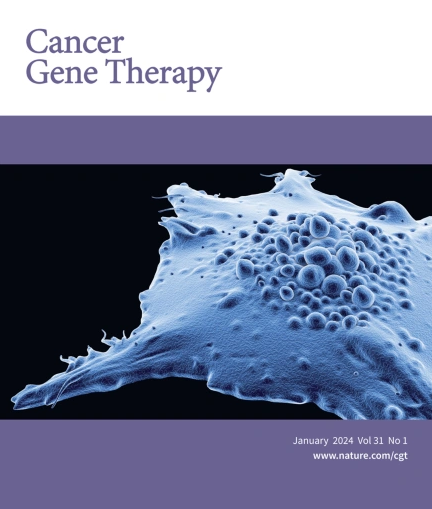PHF10 可抑制胃上皮细胞分化并诱导胃癌发生。
IF 4.8
3区 医学
Q1 BIOTECHNOLOGY & APPLIED MICROBIOLOGY
引用次数: 0
摘要
胃癌(GC)以分化障碍为特征,其确切机制尚不清楚。我们之前的研究表明,PHF10 在胃癌中具有致癌特性,其组织学表现表明它在胃癌分化障碍的调节中可能发挥作用。本研究揭示了 PHF10 在 GC 组织中的显著上调,并与分化水平呈负相关。研究发现,PHF10 会阻碍 GC 细胞的分化,同时促进其干细胞特性。这是因为 PHF10 和 E2F1 之间形成了正反馈回路,导致 GC 中的表达水平失调。此外,研究还发现 PHF10 通过组装 SWI/SNF 复合物介导了 GC 细胞中靶基因 DUSP5 的转录抑制,导致 pERK1/2 水平升高。在 GC 组织中,E2F1 或 PHF10 的表达与 DUSP5 之间呈负相关,而 E2F1 或 PHF10 的表达与 pERK1/2 之间呈正相关。额外的拯救实验证实,PHF10 对 GC 细胞分化的抑制作用依赖于 DUSP5-pERK1/2 轴。涉及E2F1-PHF10-DUSP5-pERK1/2的信号级联被确定为调节GC细胞分化和干性的重要角色。PHF10有望成为GC细胞分化诱导疗法的靶点。本文章由计算机程序翻译,如有差异,请以英文原文为准。


PHF10 inhibits gastric epithelium differentiation and induces gastric cancer carcinogenesis
Gastric cancer (GC) is characterized with differentiation disorders, the precise mechanisms of which remain unknown. Our previous study showed that PHF10 exhibits oncogenic properties in GC, with its histological presentation indicating a potential role in the modulation of differentiation disorders in GC. This study reveals a significant upregulation of PHF10 in GC tissues, showing a negative correlation with differentiation level. PHF10 was found to impede the differentiation of GC cells while promoting their stemness properties. This was attributed to the formation of a positive feedback loop between PHF10 and E2F1, resulting in dysregulated expression levels in GC. Additionally, PHF10 was found to mediate the transcriptional repression of the target gene DUSP5 in GC cells through the assembly of the SWI/SNF complex, leading to an elevation in pERK1/2 levels. In GC tissues, a negative association was noted between the expression of E2F1 or PHF10 and DUSP5, whereas a positive correlation was observed between the expression of E2F1 or PHF10 and pERK1/2. Additional rescue experiments confirmed that the inhibitory effect on differentiation of GC cells by PHF10 is dependent on the DUSP5-pERK1/2 axis. The signaling cascade involving E2F1-PHF10-DUSP5-pERK1/2 was identified as an important player in regulating differentiation and stemness in GC cells. PHF10 emerges as a promising target for differentiation induction therapy in GC.
求助全文
通过发布文献求助,成功后即可免费获取论文全文。
去求助
来源期刊

Cancer gene therapy
医学-生物工程与应用微生物
CiteScore
10.20
自引率
0.00%
发文量
150
审稿时长
4-8 weeks
期刊介绍:
Cancer Gene Therapy is the essential gene and cellular therapy resource for cancer researchers and clinicians, keeping readers up to date with the latest developments in gene and cellular therapies for cancer. The journal publishes original laboratory and clinical research papers, case reports and review articles. Publication topics include RNAi approaches, drug resistance, hematopoietic progenitor cell gene transfer, cancer stem cells, cellular therapies, homologous recombination, ribozyme technology, antisense technology, tumor immunotherapy and tumor suppressors, translational research, cancer therapy, gene delivery systems (viral and non-viral), anti-gene therapy (antisense, siRNA & ribozymes), apoptosis; mechanisms and therapies, vaccine development, immunology and immunotherapy, DNA synthesis and repair.
Cancer Gene Therapy publishes the results of laboratory investigations, preclinical studies, and clinical trials in the field of gene transfer/gene therapy and cellular therapies as applied to cancer research. Types of articles published include original research articles; case reports; brief communications; review articles in the main fields of drug resistance/sensitivity, gene therapy, cellular therapy, tumor suppressor and anti-oncogene therapy, cytokine/tumor immunotherapy, etc.; industry perspectives; and letters to the editor.
 求助内容:
求助内容: 应助结果提醒方式:
应助结果提醒方式:


